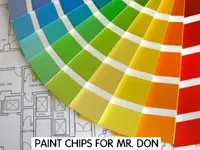Re: discussion on the various possible theories that may be applicable to LrL's
Well, I couldn't wait to find out if I can feel the slipperyness change when I change colors.
So I opened a browser and went to this site to get some colors to experiment with:
http://1zelda.com/tv/pics/rgb_test.jpg
I saw a fat red, green and blue stripe across the browser. The right side is bright, and the left side is dark. So I started rubbing on the red stripe at the top right where it is bright. After a few minutes I got used to the feel of the screen. Then I moved my finger down and continued rubbing on the green stripe. It did not feel any more or less slippery. But it did feel different. It felt like there were two small bumps in the green stripe. But I couldn't see any bumps.
Is this the telltale way we can "see" colors that Mr. Don was talking about?

I rubbed back in the red stripe, and still no bump feel there. But the green stripe definitely produces bump feelings that are repeatable.
Next I began rubbing below on the blue stripe. The blue stripe felt dusty, so I brushed off the dust and continued feeling for slipperyness. It felt the same slipperyness as the green and red stripes. But it had bump feelings also like the green stripe. Except they felt bigger, and more of them.
Hmmm.... This bears further investigation.

I moved the browser down on the screen so the bottom half was off the screen, and the green stripe was now positioned at the lower screen. Then I rubbed the green stripe, and I felt the same larger bumps as I felt when the blue stripe was there. Hmmm....
Next I moved the browser farther down on the screen until only the red stripe showed at the bottom of the screen. When I checked the red stripe with the rub test, I felt the same larger bumps as I felt when the blue stripe and green stripe was there. Hmmm....
Next, I got out a magnifying glass and made a close inspection of the lower part of my screen. After close examination, I discovered some small dried beer spots on the bottom part of the screen. So I got a damp sponge and cleaned the screen. After the screen dried, I tried the rubbing experiments again. I was not able to find any bumps or any change in the slipperiness at any of the three colors whether I rubbed in a single spot and moved the colors under my finger, or if I moved my finger to different parts of the screen to find different colors. One cool test was to rub up and down across the red, green and blue stripes to see if my finger would try to skid more in any particular color. It didn't.

Oh well, It was an hour and a half well spent. I learned whether I could train my fingers to see colors or not.
I wonder when Mr. Don will get back from Radio Shack?

Best wishes,
J_P
















